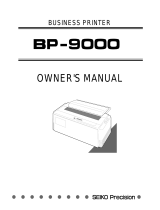
Rev. A 11
Confidential
3 FAQ
Q. Is there a driver that can use the right side up printing mode?
A. Sorry, no drivers or utilities canuse the right side up printing mode.
No printer drivers or utilities support the right side up printing mode (the specific command
method or DIP switch setting method).
If you use a driver or utility when the printer’s DIP switch 1-1 is ON (Right side up printing
mode) the printer’s performance is not guaranteed.
Q. During right side up printing mode, can any status be transmitted from a
printer as in normal printing mode?
A. Any status will be transmitted from the printer to the host PC; however, the
transmitted timing may be different.
During right side up printing mode (specific command method, or DIP switch setting
method), when a printer receives a GS r, GS I, or GS a comand, the printer transmits the
required status before printing the currrent stored text data. Therefore, if you use GS r and
GS I to confirm the printer has printed print data, these commands can't send you this
information during right side up printing mode.
ASB status is transmitted from host PC the same as in normal mode. However, it is
transmitted before printing the currrent stored text data when ASB function is set to
enabled.
Q. A utility can’t work correctly for TM-U220.
A. Sorry, utilities can’t use the right side up printing mode.
No utilities support the right side up printing mode. Turn off DIP switch 1-1 (normal
printing mode) when using a utility.
Q. The printer doesn’t print correctly in the right side up printing mode.
A. Confirm the following items.
• Some commands are forbiden commands during the right side up printing mode. Check
whether your application transmits any prohibited command again, please.
(See “Forbidden/Restricted commands for right side up printing mode” on page 8.)
• Turn off the DIP switch 1-2 (receive buffer: 4KB.)
• Confirm that the receive buffer is not full. When the receive buffer is full, the print result
isn’t guaranteed.Arrange your application to prevent a receive buffer full.
(Ex. Divide the text into two or more the reverse print data blocks by using a specific
command.)
Q. Is the drawer kick-out connection enabled during the right side up mode?
A. It can be driven; however, the drive timing is slightly different.





















